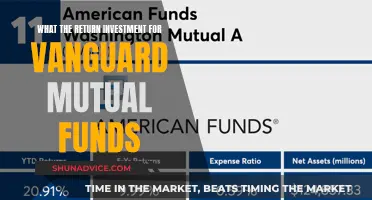
Retirement funds are a crucial aspect of financial planning, offering a means to secure one's future during the golden years. When it comes to investing these funds, there are numerous options available, each with its own set of advantages and considerations. The chosen investment vehicles will depend on factors such as risk tolerance, time horizon, and overall financial goals. Here's an overview of some common investment choices for retirement funds:
- Tax-Advantaged Accounts: These include 401(k) plans and Individual Retirement Accounts (IRAs), which provide tax benefits that help your savings grow over time. 401(k) plans are typically offered by employers and may include matching contributions, making them a popular choice. IRAs, on the other hand, can be opened at financial institutions and offer tax-deductible contributions or tax-free withdrawals, depending on the type chosen.
- Stocks and Mutual Funds: Investing in stocks provides an opportunity for capital appreciation and, in some cases, dividend income. Mutual funds, on the other hand, offer a diversified approach by pooling money from multiple investors to purchase a variety of securities, providing a balanced portfolio.
- Bonds: Fixed-income instruments like bonds are a more conservative investment option. They offer steady income through periodic interest payments and can be purchased individually or through bond mutual funds.
- Annuities: Annuities are insurance contracts that guarantee regular income payments during retirement. They can be complex, with different types such as fixed, variable, and index annuities, each carrying its own set of risks and benefits.
- Real Estate: Investing in rental properties or Real Estate Investment Trusts (REITs) can provide a steady income stream. However, it requires active management or hiring a property management company.
- Dividend-Paying Stocks: Some investors prefer stocks that pay out dividends as a way to generate consistent income. While this approach may provide steady returns, it's important to note that not all companies are reliable in their dividend payouts.
| Characteristics | Values |
|---|---|
| Type of Account | Tax-Advantaged Accounts, Taxable Accounts |
| Tax Treatment | Tax-Deferred, After-Tax |
| Investment Options | Stocks, Bonds, Mutual Funds, ETFs, CDs, Annuities, Dividend-Paying Stocks, Rental Property, REITs, Income-Producing Equities, Cash, Money Market Deposit Accounts, DRIPs |
What You'll Learn

Tax-advantaged accounts
Tax-Deferred Accounts
Tax-deferred accounts allow you to make pre-tax contributions, which are excluded from your taxable income. Taxes are paid when you withdraw the money, typically during retirement. Examples of tax-deferred accounts include traditional 401(k) plans, traditional IRAs (Individual Retirement Accounts), and employer-based retirement plans such as 403(b) and 457 plans.
Tax-Exempt Accounts
Tax-exempt accounts, on the other hand, are funded with after-tax dollars. The advantage of these accounts is that investments grow tax-free, and qualified withdrawals can be made tax-free. Examples of tax-exempt accounts include Roth 401(k)s, Roth IRAs, and 529 college savings plans.
Choosing Between Tax-Deferred and Tax-Exempt Accounts
The choice between tax-deferred and tax-exempt accounts depends on your financial situation and goals. Generally, if you are in a lower tax bracket now than you expect to be during retirement, it may be beneficial to pay taxes upfront with a tax-exempt account. On the other hand, if you anticipate being in a higher tax bracket during retirement, a tax-deferred account can help you postpone paying taxes until a later date.
Other Considerations
It's important to note that tax-advantaged accounts come with rules and restrictions, such as contribution limits, timing of withdrawals, and eligibility requirements. Additionally, certain accounts may offer employer-matching contributions, which can boost your savings. When deciding which type of account to use, it's essential to consider your current and expected future tax brackets, savings goals, and time horizons. Consulting with a financial advisor or tax professional can help you navigate the complexities and make informed decisions.
Understanding Investment Funds Securities: Risks and Rewards
You may want to see also

Asset allocation
The longer your investment timeline, the more of your portfolio you should hold in stocks. As investors get closer to retirement age, they can reduce their risk tolerance and reallocate their portfolio to include more bonds, which have had lower returns on average but less variability.
For example, if you are younger than 50 and saving for retirement, you can consider investing heavily in stocks. As you reach your 50s, you may want to allocate 60% of your portfolio to stocks and 40% to bonds, adjusting according to your risk tolerance. Once retired, you may prefer a more conservative allocation of 50% in stocks and 50% in bonds.
It is also important to diversify within these asset classes. For example, within stocks, you can invest in different types such as small-cap, large-cap, international, etc. Within bonds, you can invest in municipal, corporate, and government bonds.
You can implement an asset allocation strategy using a target-date fund, which automatically adjusts its investments from risky to less risky closer to your retirement. Alternatively, you can have more control over your asset allocation by using a two-fund or three-fund portfolio, investing in a mix of well-diversified index funds.
- Your age: As you get older, your risk tolerance typically decreases, and you may want to reduce the proportion of stocks in your portfolio.
- Risk tolerance: Consider your innate risk tolerance and adjust your asset allocation accordingly. If you are comfortable with more risk, you may want to allocate more to stocks, while a more conservative approach might favour bonds and cash.
- Time horizon: If you have a long-term investment horizon, you can typically withstand more volatility and allocate more to stocks. If you are nearing retirement, you may want to focus more on stable, low-earning funds.
- Market conditions: Don't let short-term market conditions dictate your allocation strategy. Instead, follow a planned strategy as it is impossible to time the market.
- Diversification: Diversify across and within asset classes to reduce the risk of losing money and provide a more balanced portfolio.
By carefully considering these factors and choosing an appropriate asset allocation strategy, you can increase your wealth and meet your retirement goals.
Mutual Fund Investment: Income Generation Strategy
You may want to see also

Robo-advisors or target date funds
Robo-advisors are investment platforms that manage investments on an investor’s behalf using survey responses and algorithms. They are a cost-effective way for investors to grow their capital through an automated investing service without having high service fees eating away at their profits. The fees and entry requirements associated with these digital wealth management platforms are generally much less than those of a human financial advisor.
Robo-advisors are ideal for those who don't have the time or commitment to investing but still want to build wealth. They are also suitable for those who don't have the capital for a human financial advisor, as robo-advisors often have low or no account minimums.
Robo-advisors use modern portfolio theory (MPT) to select investments to maximise returns within an acceptable level of risk through diversification. They differ in their complexity and asset offerings, as well as account minimums and costs. Some robo-advisors offer access to human financial advisors, either as a standard feature or for an additional cost.
- Wealthfront: Best Overall, Best for Goal Planning, Best for Portfolio Construction, and Best for Portfolio Management
- Betterment: Best for Beginners, Best for Cash Management, Best for Tax-Loss Harvesting, and Best for Crypto Portfolio Selection
- SoFi Automated Investing: Best for Low Costs
- M1 Finance: Best for Sophisticated Investors
- Acorns: Best for Those Who Struggle to Save
- Ellevest: Best for Women Investors
- ETRADE Core Portfolios: Best for Mobile
- Merrill Guided Investing: Best for Education
Target-date funds are mutual funds designed for retirement savers that automatically rebalance and adjust their asset mix as investors get closer to retirement. For example, a target-date fund for people retiring in 2055 will start out weighted more heavily in stocks and will transition to a heavier weighting in less-risky assets as that date approaches.
Target-date funds are a modern approach to investing for retirement, as they are managed for you, removing the need to spend time selecting retirement investments and remembering to rebalance. This also lessens the chance of throwing your strategy off course by tinkering with your investment choices in the future.
- Vanguard Target Retirement Funds: Each fund invests in Vanguard's broadest index funds, giving access to thousands of U.S. and international stocks and bonds. The fund managers gradually shift each fund's asset allocation to fewer stocks and more bonds so the fund becomes more conservative as the target date approaches.
- Fidelity Freedom Funds: These funds adjust their mix of stocks and bonds based on the target retirement date and offer different options depending on investors' risk tolerance.
- T. Rowe Price Target Funds: These funds are designed to provide a balance between equity and fixed-income exposure, with a glide path that becomes more conservative as the target date approaches.
- Schwab Target Index Funds: These funds are designed to become more conservative as the target date approaches, with a mix of stocks and bonds that aims to provide capital appreciation and income.
Strategies to Attract Investors to Your Fund
You may want to see also

Dividend-paying stocks
When choosing dividend stocks for your retirement portfolio, it's important to select companies with a history of consistent dividend payments and stable performance. Additionally, look for companies that can afford to make their dividend payments from their free cash flow (FCF). This indicates that the company is financially healthy and can sustain its dividend payouts over the long term.
It's also crucial to diversify your dividend stocks across different business sectors to minimize risk. By investing in various industries, you reduce the impact of any one sector's performance on your overall portfolio.
However, it's important to remember that dividends are not guaranteed, and companies may choose not to declare them. Therefore, it's crucial to conduct thorough research and due diligence when selecting dividend stocks for your retirement portfolio.
- Visa (V): Visa is a data network company that sells its payment processing network to debt, credit card, and other payments companies. It has low capital expenditures and generates a large amount of free cash flow. Visa has a history of 15 years of consecutive dividend growth, and its dividend yield is currently at 0.8%.
- Microsoft (MSFT): Microsoft is a well-known global company with a large market share in personal computer software. It is expanding into enterprise software services and artificial intelligence applications. Microsoft has a strong free cash flow and has consistently increased its dividend for 19 consecutive years. Its current dividend yield is 0.7%.
- Lockheed Martin (LMT): Lockheed Martin is an aeronautics, defense, and space technology company with strong and consistent free cash flow. They have a history of 21 years of consecutive dividend growth, and their dividend yield is 2.7%.
- Chevron (CVX): Chevron is a large oil and gas company that generates significant free cash flow. They have consistently increased their dividend payouts for 37 years, and their dividend yield is currently at 4.2%.
- Domino's Pizza (DPZ): Domino's Pizza is the largest pizza company in the world, generating consistent and significant free cash flow. They have increased their dividend for 10 consecutive years, and their dividend yield is 1.2%.
Equity Fund Investment: Where to Begin?
You may want to see also

Rental property
Rental properties can be a profitable way to fund your retirement, but it takes knowledge of the real estate market, starting capital, and patience.
Appreciation
Firstly, real estate appreciates over time. The rising value of property leads to more equity and a higher dollar amount for your home. However, this appreciation depends on several factors, such as the current housing market, the location of the property, and interest rate trends.
Steady Income
Rental properties provide a steady income, as landlords set the rental rates for each property, determining their monthly income. However, this income depends on having tenants occupy the properties.
Tax Benefits
Rental properties also offer tax benefits, as landlords can deduct certain expenses, such as mortgage interest, property taxes, and necessary home improvements.
Capital
To fund your retirement with rental properties, you need the capital to purchase them. Most banks expect a 25% down payment for investment properties and a solid income history or well-established savings account.
Repairs, Taxes, and Fees
In addition to the initial cost of the property, prospective landlords must consider the costs of repairs, renovations, and tenants' wear and tear. There are also taxes on rental properties and fees such as HOA fees and management fees.
Landlord Responsibilities
Owning rental properties can quickly become a full-time job, which is not ideal for retirement. Landlords must consider the time and effort required for maintenance, repairs, tenant screening, rent collection, and lease construction.
Alternative Options
If you don't want to manage the property yourself, you can hire a property management team, but this will incur an additional monthly fee. Alternatively, you can use your retirement funds to invest in real estate through a self-directed IRA or a Roth IRA, though this process can be tricky and requires careful consideration of the associated risks and regulations.
Debt Fund Investment: Timing and Strategy
You may want to see also
Frequently asked questions
Retirement funds can invest in a variety of things, including stocks, bonds, cash, mutual funds, ETFs (exchange-traded funds), CDs (certificates of deposit), and real estate.
A 401(k) plan is a tax-advantaged retirement savings plan offered by employers. It allows employees to contribute a portion of their wages on a pre-tax or after-tax basis, depending on the type of 401(k) plan. The money in the plan can then be invested in various assets, such as stocks, bonds, mutual funds, or ETFs.
A traditional IRA is a tax-advantaged retirement account that allows individuals to contribute pre-tax dollars. Withdrawals from a traditional IRA are taxed as ordinary income in retirement. On the other hand, a Roth IRA is funded with after-tax dollars, and qualified distributions are generally tax-free.
In addition to traditional retirement plans like 401(k)s and IRAs, individuals can also consider alternative options such as HSAs (health savings accounts) and 529 plans, which are typically used for education savings but can also be utilised for retirement. Other alternatives include investing in dividend-paying stocks, rental properties, annuities, or income-producing equities.







